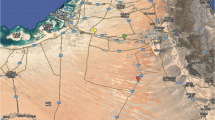Abstract
It has been found that unknown meteor showers could be efficiently discovered from the single station video meteor database of the International Meteor Organization (IMO) by assuming the geocentric velocity and adjusting it within the dynamically permitted range. The mean geocentric velocities of new meteor showers can be obtained, as well as the coordinates of the radiants. The activity period and maximum time can also be obtained if there are sufficient shower meteors. All single station video meteor observations between February 13 and 17 (from 2000 to 2005) in IMO’s database are processed with this method. As a result, two new meteor showers, one near RA=245.10°, Dec=41.82° in Hercules and the other near RA=233.03°, Dec=17.04° in Serpenids, are discovered. Some dynamical characteristics of the new meteor showers are also determined. Considering the random nature on the selection of period in this work, it is expected that there are some more potential new meteor showers in IMO’s video database.
Similar content being viewed by others
References
Belkobich O. Visual meteor observations—What is the use? In: Roggemans P, Arlt R, eds. Proceedings of the International Meteor Conference. Potsdam: International Meteor Organization, 1991. 27–29
Molau S, Nitschke M, de Lignie M, et al. Video observations of meteors: History, current status, and future prospects. WGN J Int Meteor Organ, 1997, 25: 15–20
Arlt R, Rendtel J. The activity of the 2004 Geminid meteor shower from global visual observations. Mon Not Royal Astron Soc, 2006, 367(4): 1721–1726
de Lignie M, Betlem H. A double-station video look on the October meteor Showers. WGN J Int Meteor Organ, 1999, 27: 195–201
Shigeno Y, Shioi H, Tanaka S. Double-station TV meteor observations in 1996. WGN J Int Meteor Organ, 1997, 25: 161–165
Shigeno Y, Shioi H. Double-station TV meteor observations. WGN J Int Meteor Organ, 1996, 24: 37–42
Triglav-Cekada M, Arlt R. The summer pegasids from IMO video data. WGN J Int Meteor Organ, 2005, 33: 129–134
Arlt R. The software RADIANT. WGN J Int Meteor Organ, 1992, 20: 62–69
Author information
Authors and Affiliations
Corresponding authors
Additional information
Supported by the National Natural Science Foundation of China (Grant No. 10373004)
Rights and permissions
About this article
Cite this article
Li, J., Zhu, J. A new method of discovering new meteor showers from the IMO single-station video meteor database. Sci. China Ser. G-Phys. Mech. Astron. 51, 1170–1178 (2008). https://doi.org/10.1007/s11433-008-0098-2
Received:
Accepted:
Published:
Issue Date:
DOI: https://doi.org/10.1007/s11433-008-0098-2




